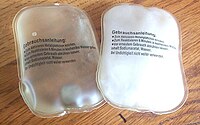
Photo from wikipedia
Abstract High latent heat, no leakage and recyclable are the comprehensive properties of phase change materials (PCMs). In this study, which was inspired by the structures of orange and pomegranate,… Click to show full abstract
Abstract High latent heat, no leakage and recyclable are the comprehensive properties of phase change materials (PCMs). In this study, which was inspired by the structures of orange and pomegranate, a facile strategy via a self-template method was adopted to prepare form-stable phase change materials (FSPCMs) for the first time. Utilising poly(ethylene glycol) (PEG) spherulite crystals as templates, the cross-linked polymer (named CPA) was prepared as a supporting material by in situ polyaddition. The bionic vesicle structure microstructures were investigated by parallel optical stereo microscope and scanning electron microscope. The results suggest that a vesicle-like structure is formed in the prepared PEG/CPA FSPCMs. Compared with the FSPCMs prepared by interpenetrating cross-linked network method, the FSPCMs prepared by self-template method has higher PEG loading value. Especially, when PEG-20K (the molecular weight is 20 K) with a larger spherulite diameter was used as a template to prepare PEG-20K/CPA FSPCMs, the loading value was as high as 900%. Moreover, in a process attributed to the regeneration of various types of hydrogen bonds, ionic bonds and transesterification, the recyclable CPA enables the PEG-20K/CPA (9/1) FSPCMs to possess good thermally reversible reusability.
Journal Title: Chemical Engineering Journal
Year Published: 2020
Link to full text (if available)
Share on Social Media: Sign Up to like & get
recommendations!